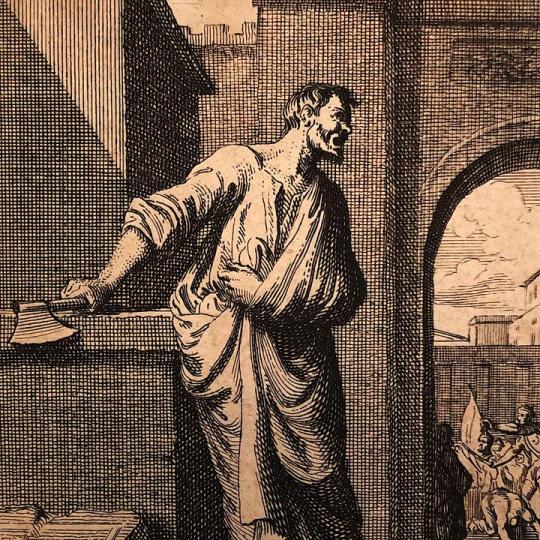#louis du guernier
Text
Shakespeare Weekend!
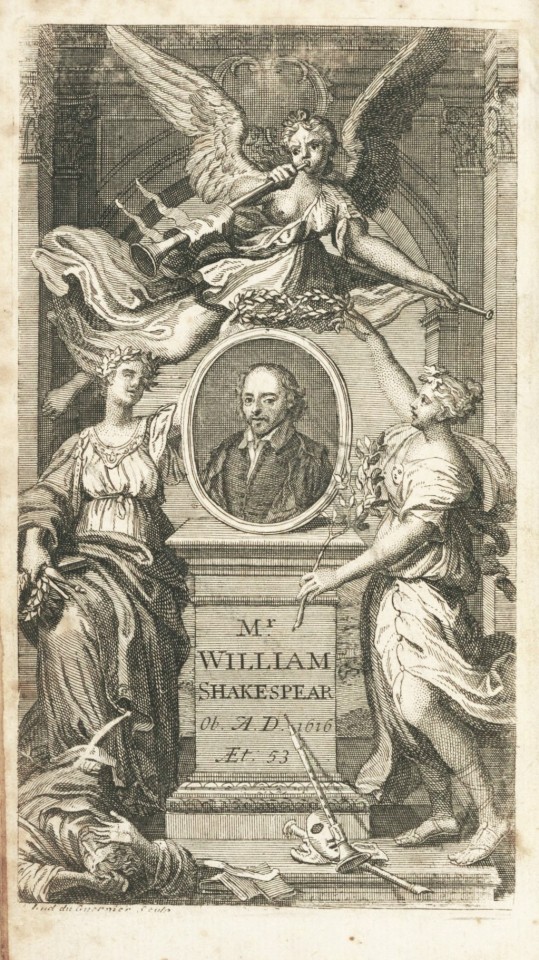
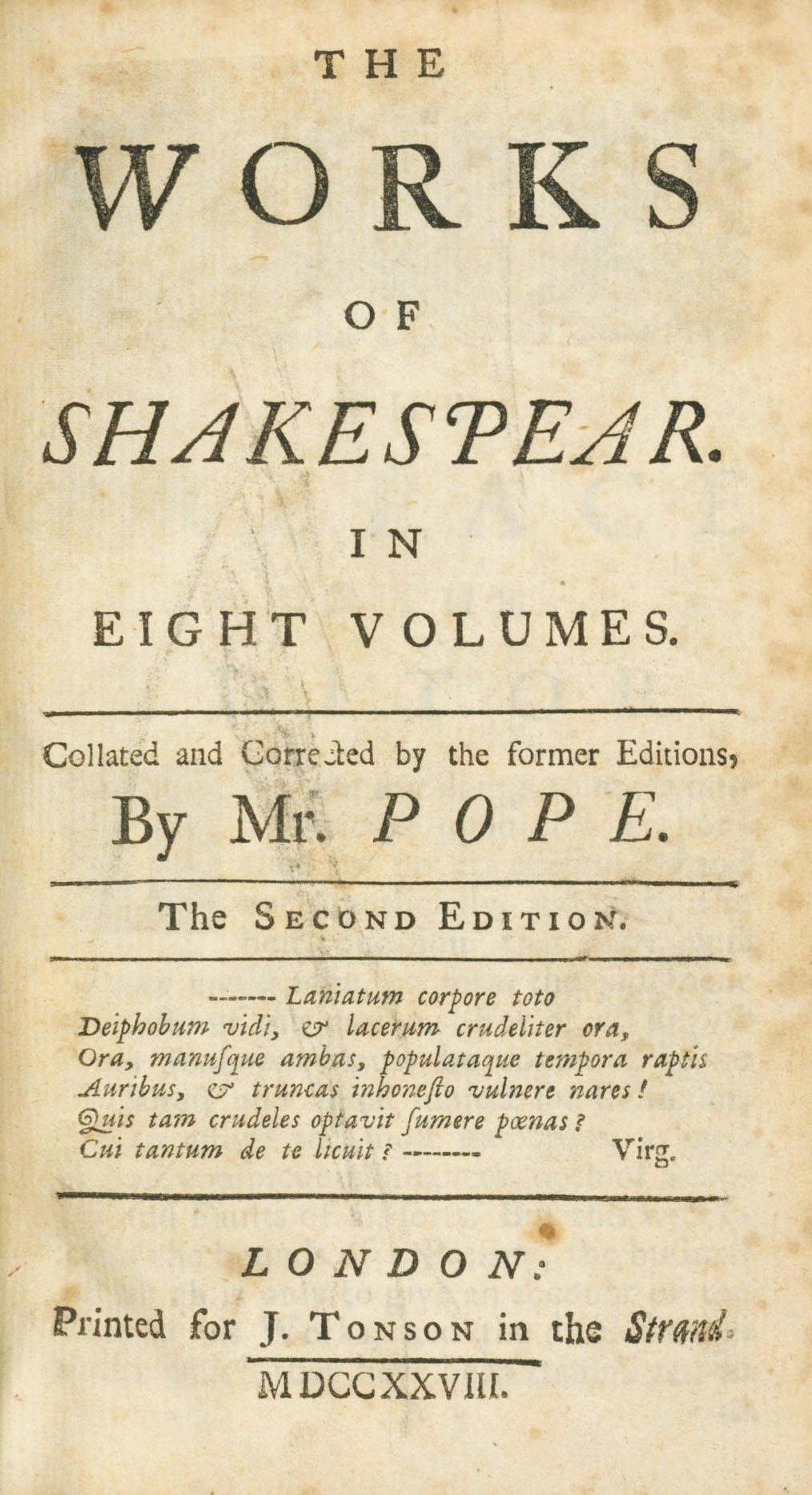


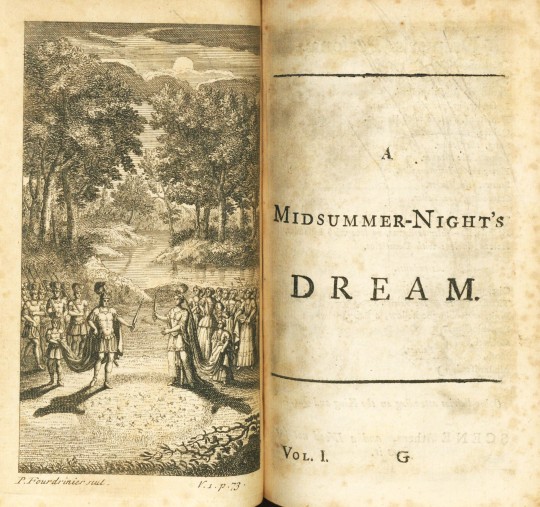



The next illustrated collection of Shakespeare from our holdings is the second edition of The Works of Mr. William Shakespear: In Ten Volumes published by Alexander Pope (1688-1744) and Dr. George Sewell (d. 1726) for Jacob Tonson (1655-1736). Pope’s second edition was published in eight volumes in 1728, followed by supplementary ninth and tenth volumes. Sewell is only credited within the tenth volume.
Volume One includes a preface by Pope followed by Nicholas Rowe’s biographical essay Some Account of the Life of Mr. William Shakespear and a poem in memory of Shakespeare by English dramatist Ben Jonson (1572-1637). Plays contained within volume one include The Tempest, A Midsummer Night’s Dream, The Two Gentlemen of Verona, The Merry Wives of Windsor, and Measure for Measure.
Pope’s editions of Shakespeare were the first attempted to collate all previous publications in order to help determine authorial text and regularize Shakespearean metre. He consulted twenty-seven early quartos restoring passages that had been out of print for almost a century. Pope also took liberties in removing about 1,560 lines of material that didn’t appeal to him. Some such lines were degraded to the bottom of the page with his other editorial notes. At the time, his editorial hand was met with some criticism and dismissal but historically it may be seen as one of the first scholarly approaches to Shakespeare.
Pope followed in Rowe’s footsteps including scene divisions, stage directions, dramatis personae, and full-page engravings preceding each play. Volume One’s engravings are attributed to French artist Louis Du Guernier (1677-1716) and Englishman Paul Fourdrinier (1698-1758). Dedicated readers of Shakespeare Weekend may notice some of the engravings’ extreme similarities to François Boitard’s work from Rowe’s volumes, particularly in the frontispiece interpretation of Shakespeare's Stratford monument.
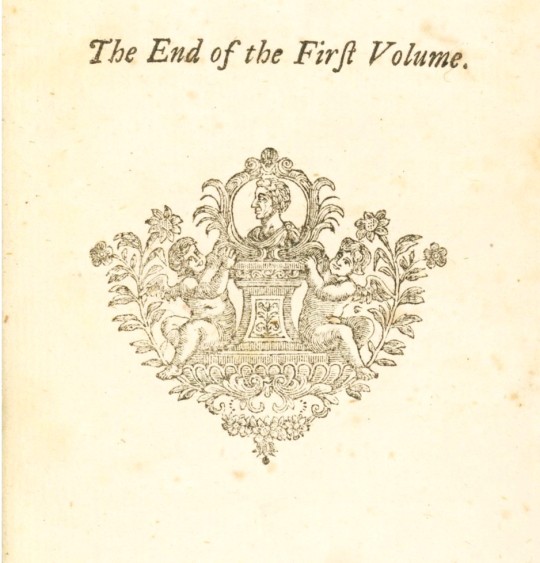
View more Shakespeare Weekend posts.
-Jenna, Special Collections Graduate Intern
#Shakespeare Weekend#william shakespeare#shakespeare#the works of mr. william shakespear: in ten volumes#alexander pope#dr. george sewell#george sewell#jacob tonson#nicholas rowe#ben johnson#the tempest#a midsummer night's dream#the two gentlemen of verona#the merry wives of windsor#measure for measure#louis du guernier#paul fourdrinier#francois boitard#engraving
33 notes
·
View notes
Photo

From our stacks: Frontispiece “Poetaster. Lud. Du Guernier inv. et sculp.” from The Works of Ben Jonson. Volume the Second. Containing Poetaster, or his Arraignment. Sejanus his Fall. Volpone, or The Fox. Epicoene, or, The Silent Woman. London: Printed for D. Midwinter; W. Innys and J. Richardson; J. Knapton; T. Wotton; C. Hitch and L. Hawes; J. Walthoe; D. Browne; J. and R. Tonson; C. Bathurst; J. Hodges; J. Ward; M. and T. Longman; W. Johnston; and P. Davey and B. Law. 1756.
#poetaster#ben jonson#louis du guernier#du guernier#engraving#illustration#book illustration#engravings#etching#etchings#art#book#books#old book#old books#18th century#18th century book#18th century books#poetry#poet#poets#english lit#english literature#literature#lit#detroit public library
19 notes
·
View notes
Text
Shakespeare Weekend
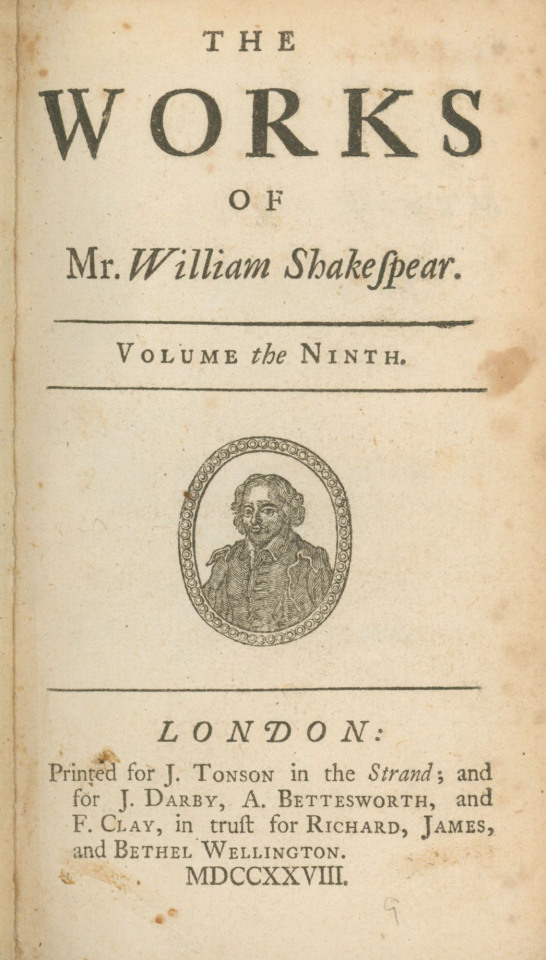
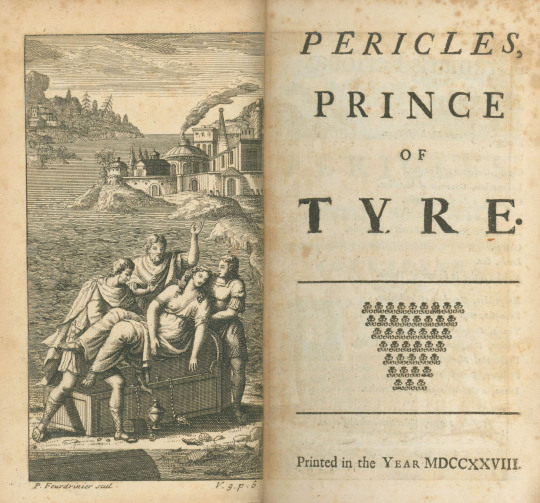
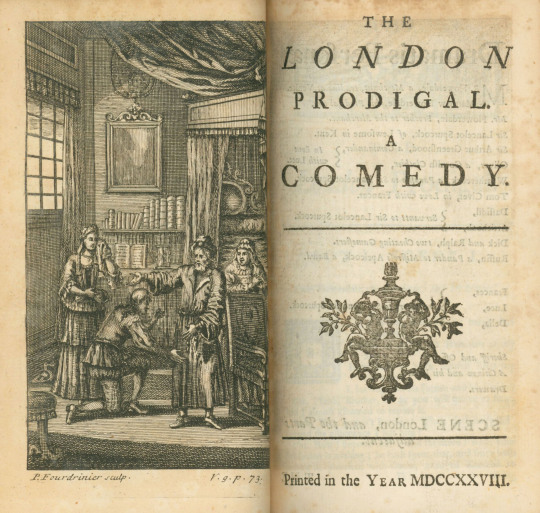
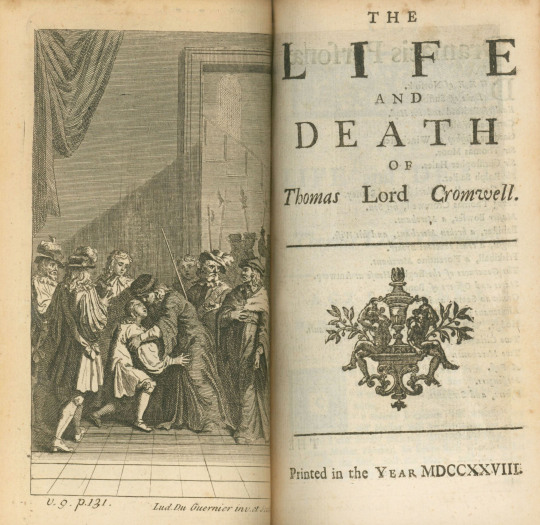

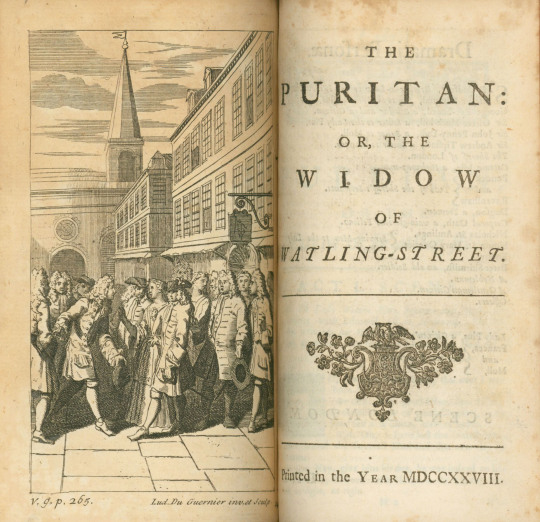

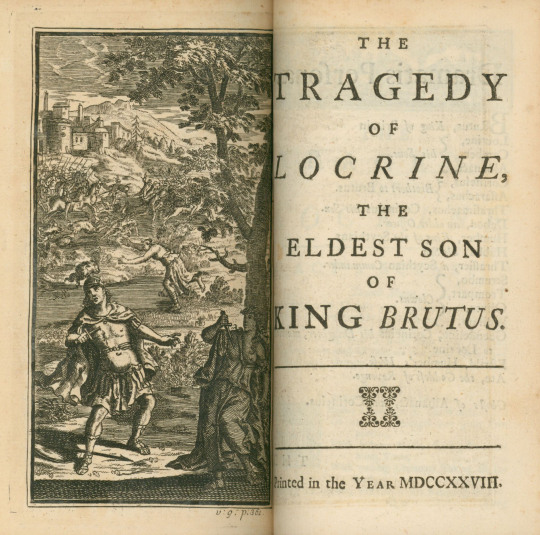
The ninth volume of The works of Mr. William Shakespear: in ten volumes published in 1728 by Alexander Pope (1688-1744) and Dr. George Sewell (d. 1726) for Jacob Tonson (1655-1736), is considered a supplementary volume added to the collection in the second edition. As previously mentioned, Volume 9 includes the additional booksellers of C, A. Bettesworth, and F. Clay, in Trust for Richard, James, and Bethel Wellington. Scene divisions, stage directions, dramatis personae, and full-page engravings by either French artist Louis Du Guernier (1677-1716) or Englishman Paul Fourdrinier (1698-1758) precede each play.
The volume contains seven plays; Pericles, Prince of Tyre, The London Prodigal, Thomas Lord Cromwell, Sir John Oldcastle, The Puritan, A Yorkshire Tragedy, and Locrine. Thematically the plays span genres ranging from comedy, tragedy and history, but they all share the same underlying question over authorship. The plays were originally attributed to William Shakespeare due to “Written by W.S.” appearing on the title pages of early quartos. Scholars have since argued that the “W.S.” could alternatively credit dramatists and Shakespeare contemporaries Wentworth Smith or William Sly, and historians now attribute Sir John Oldcastle and A Yorkshire Tragedy to prolific Jacobean playwright Thomas Middleton.

Except it's not the last volume, there's one more supplemental volume left that we'll look at next week!
View more Shakespeare Weekend posts.
-Jenna, Special Collections Graduate Intern
#william shakespeare#shakespeare#shakespeare weekend#the works of mr. william shakespear in ten volumes#alexander pope#dr. george sewell#jacob tonson#louis du guernier#paul fourdrinier#wentworth smith#william sly#thomas middleton
16 notes
·
View notes
Text
Shakespeare Weekend!



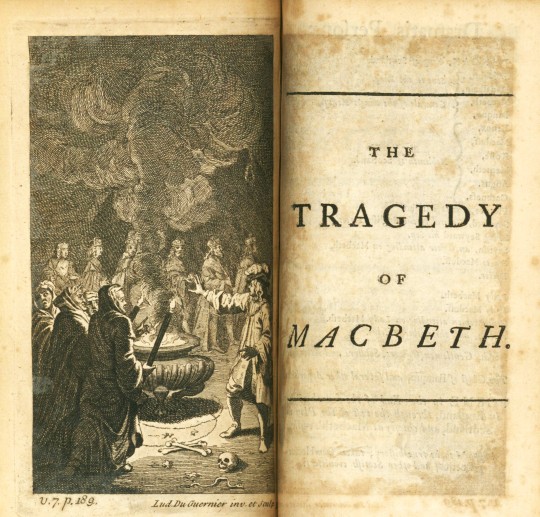

Continuing our look at The works of Mr. William Shakespear: in ten volumes published in 1728 by Alexander Pope (1688-1744) and Dr. George Sewell (d. 1726) for Jacob Tonson (1655-1736), this weekend we pore over Volume Seven.
This volume contains the tragedies Antony and Cleopatra, Titus Andronicus, The Tragedy of Macbeth, and problem play Trolius and Cressida. All four plays were published in the First Folio, however Trolius and Cressida seems to have been haphazardly squeezed in on unnumbered pages between the histories and tragedies adding to its genre identification problems. In step with Shakespeare’s other problem plays, Trolius and Cressida’s ambiguous tone bounces around creating a montage of possible intents and leaves viewers puzzled about how to relate to the characters.
The Tragedy of Macbeth is contemporarily known as a cursed play and superstitiously often referred to as The Scottish Play. Proposed origins of the curse are rumored in Shakespeare having used real witches’ spells in the text below angering witches who then cursed the play.

Like Rowe’s earlier collection, scene divisions, stage directions, dramatis personae, and full-page engravings by either French artist Louis Du Guernier (1677-1716) or Englishman Paul Fourdrinier (1698-1758) precede each play.
Pope’s editions of Shakespeare were the first attempted to collate all previous publications. He consulted twenty-seven early quartos restoring passages that had been out of print for almost a century while simultaneously removing about 1,560 lines of material that didn’t appeal to him. Some of those lines were degraded to the bottom of the page with his other editorial notes.

View more Shakespeare Weekend posts.
-Jenna, Special Collections Graduate Intern
#shakespeare weekend#the works of mr. william shakespear in ten volumes#alexander pope#dr. george sewell#jacob tonson#antony and cleopatra#titus andronicus#the tragedy of macbeth#the scottish play#trolius and cressida#problem play#louis du guernier#paul fourdrinier#engravings
19 notes
·
View notes
Text
Shakespeare Weekend
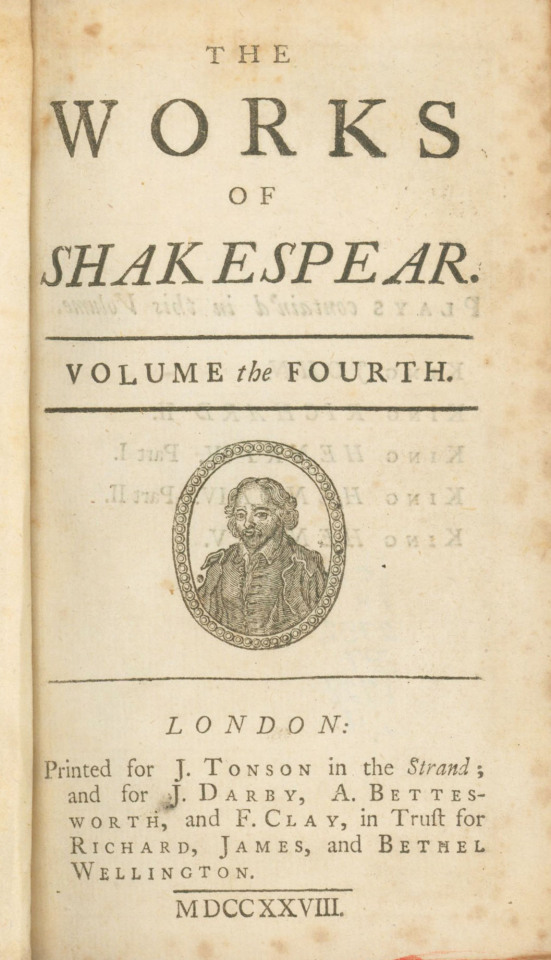

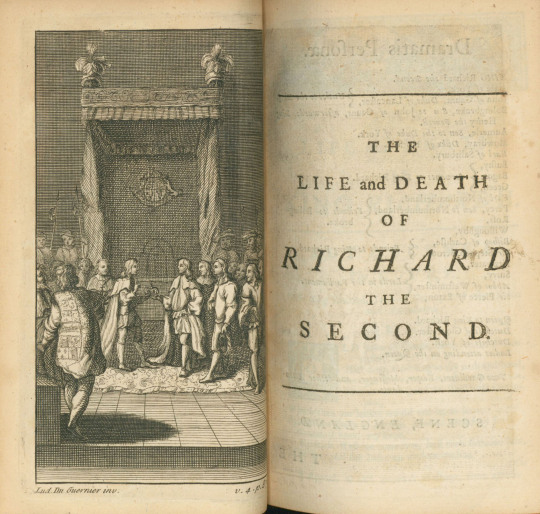
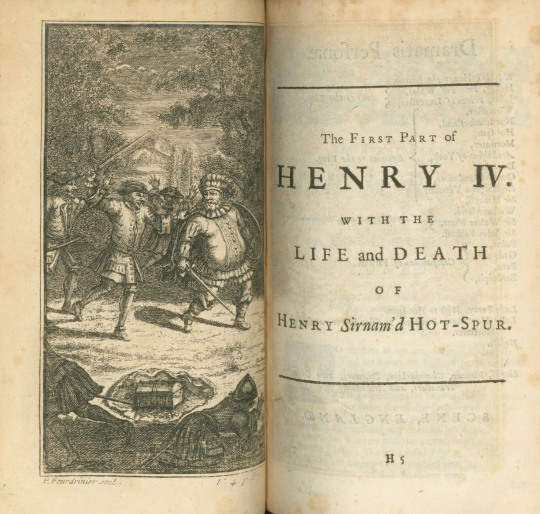
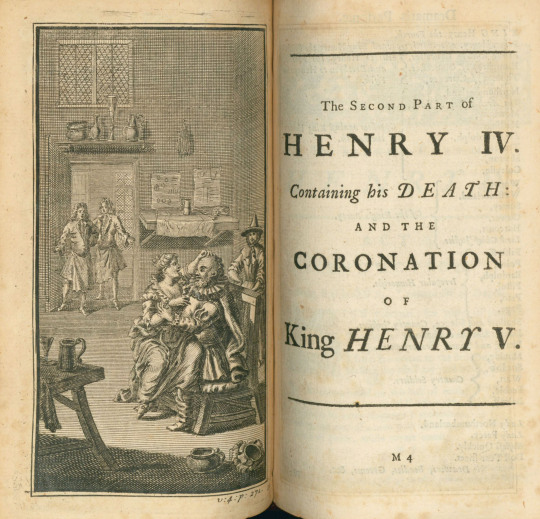
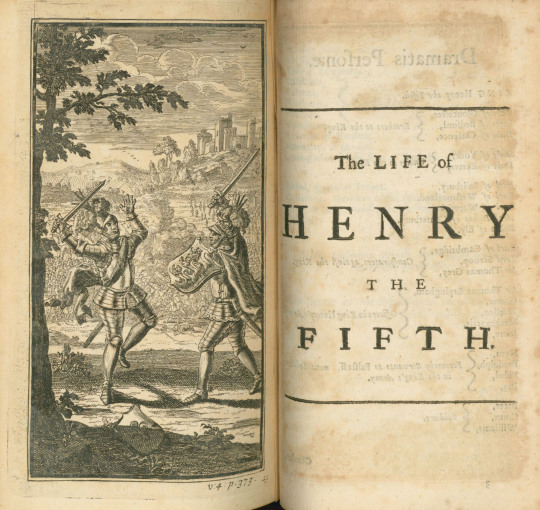
Continuing our look at The Works of Mr. William Shakespear: in ten volumes published in 1728 by Alexander Pope (1688-1744) and Dr. George Sewell (d. 1726), this week we examine Volume Four and its imprint variation on the title page. Volumes Four, Five, and Nine all include additional booksellers aside from Jacob Tonson (1655-1736).
The imprint for these three volumes reads “Printed for J. Tonson in the Strand; and for J. Darby, A. Bettesworth, and F. Clay, in Trust for Richard, James, and Bethel Wellington”. Richard Wellington Sr. was established in the London book trade during the 1700s, shortly after his death in 1715 his wife Mary assigned his stock of books over to Darby, Bettesworth, and Clay in trust for her three children. How or why Wellington was tied to only volumes four, five, and nine of Pope’s work is unknown to us.
Volume Four contains a group of Shakespearean history plays including King John, King Richard II, King Henry IV Part I, King Henry IV Part II, and King Henry. Similar to Rowe’s earlier collection, scene divisions, stage directions, dramatis personae, and full-page engravings by either French artist Louis Du Guernier (1677-1716) or Englishman Paul Fourdrinier (1698-1758) precede each play.
Pope’s editions of Shakespeare were the first attempted to collate all previous publications. He consulted twenty-seven early quartos restoring passages that had been out of print for almost a century while simultaneously removing about 1,560 lines of material that didn’t appeal to him. Some of those lines were degraded to the bottom of the page with his other editorial notes.
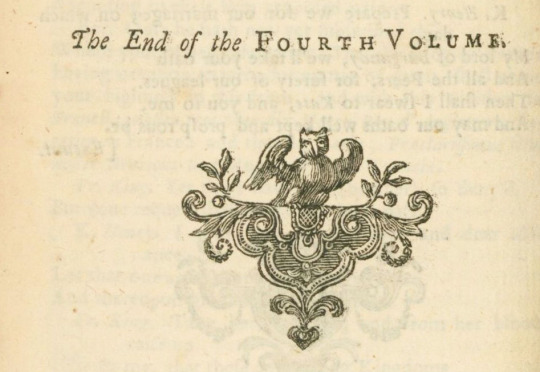
View more Shakespeare Weekend posts.
-Jenna, Special Collections Graduate Intern
#william shakespeare#shakespeare weekend#alexander pope#dr. george sewell#jacob tonson#richard wellington#j. darby#a. bettesworth#f. clay#nicholas rowe#louis du guernier#paul fourdrinier#the works of mr. william shakespear in ten volumes#shakespeare
13 notes
·
View notes
Text
Shakespeare Weekend

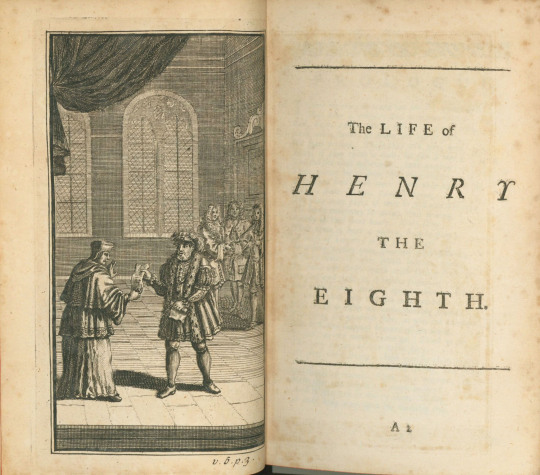

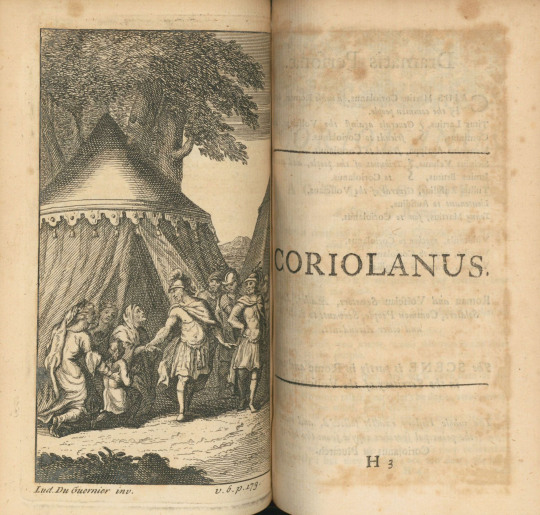

Continuing our synopsis of The works of Mr. William Shakespear: in ten volumes published in 1728 by Alexander Pope (1688-1744) and Dr. George Sewell (d. 1726) for Jacob Tonson (1655-1736), this weekend we look at Volume Six. The volume contains four plays that bounce thematically between historic and tragic, starting with Henry VIII. Based on the life of Henry VIII, the play was written in collaboration with John Fletcher (1579-1625) and is noted for having more stage directions than any other Shakespearean play.
Volume Six continues with Timon of Athens another collaboration written with Thomas Middleton (1580-1627), Coriolanus based on the life of the legendary Roman leader and one of the few Shakespearean plays to ever be banned in modern times, and Julius Caesar with its famous “Et tu? Brute!” popping up in Act 3 Scene 1.

Like Rowe’s earlier collection, scene divisions, stage directions, dramatis personae, and full-page engravings by either French artist Louis Du Guernier (1677-1716) or Englishman Paul Fourdrinier (1698-1758) precede each play.
Pope’s editions of Shakespeare were the first attempted to collate all previous publications. He consulted twenty-seven early quartos restoring passages that had been out of print for almost a century while simultaneously removing about 1,560 lines of material that didn’t appeal to him. Some of those lines were degraded to the bottom of the page with his other editorial notes.
View more Shakespeare Weekend posts.
-Jenna, Special Collections Graduate Intern
#shakespeare weekend#the works of mr. william shakespear in ten volumes#shakespeare#alexander pope#dr. george sewell#jacob tonson#henry viii#john fletcher#timon of athens#thomas middleton#coriolanus#julius caesar#nicholas rowe#louis du guernier#paul fourdrinier
15 notes
·
View notes
Text
Shakespeare Weekend

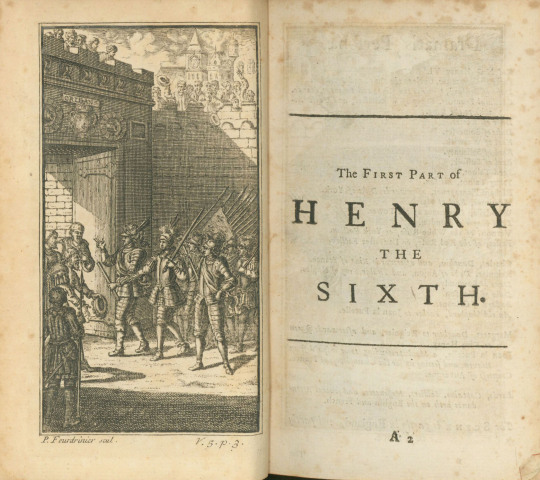
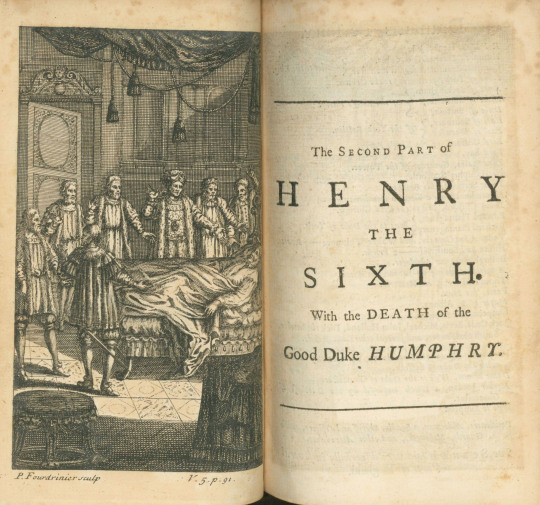


This weekend we return to The works of Mr. William Shakespear: in ten volumes with the fifth volume published in 1728 by Alexander Pope (1688-1744) and Dr. George Sewell (d. 1726) for Jacob Tonson. Volume Five is made up of King Henry VI Part I, King Henry VI Part II, King Henry VI Part III, and King Richard III. The four plays create a tetralogy that covers the entire saga of the Wars of the Roses, a series of 15th century civil wars fought to determine control of the English throne.
King Henry VI Part I enacts the loss of England’s French territories and the political momentum spurring on the Wars of the Roses. Part II delves into King Henry’s failings and the rise of the Duke of York. Part III documents the chaos and horror of war and contains one of the longest soliloquies in all of Shakespeare. The volume ends with King Richard III depicting the violent rise and short reign of King Richard III.
Like Rowe’s earlier collection, scene divisions, stage directions, dramatis personae, and full-page engravings by either French artist Louis Du Guernier (1677-1716) or Englishman Paul Fourdrinier (1698-1758) precede each play.
Pope’s editions of Shakespeare were the first attempted to collate all previous publications. He consulted twenty-seven early quartos restoring passages that had been out of print for almost a century while simultaneously removing about 1,560 lines of material that didn’t appeal to him. Some of those lines were degraded to the bottom of the page with his other editorial notes.
View more Shakespeare Weekend posts.
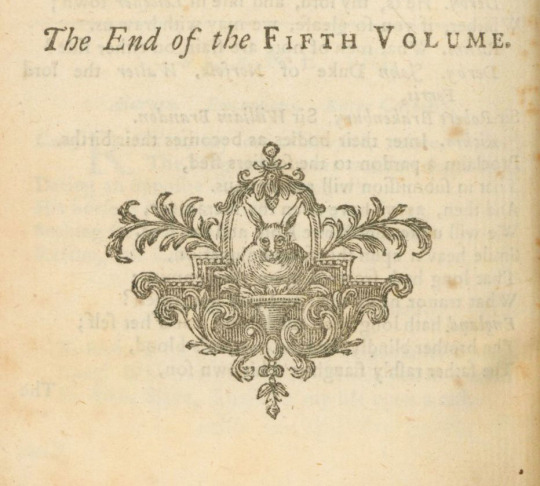
-Jenna, Special Collections Graduate Intern
#william shakespeare#shakespeare#alexander pope#dr. george sewell#jacob tonson#tetralogy#King Henry VI Part I#King Henry VI Part II#King Henry VI Part III#King Richard III#louis du guernier#paul fourdrinier#shakespeare weekend#engravings
17 notes
·
View notes
Text
Shakespeare Weekend!
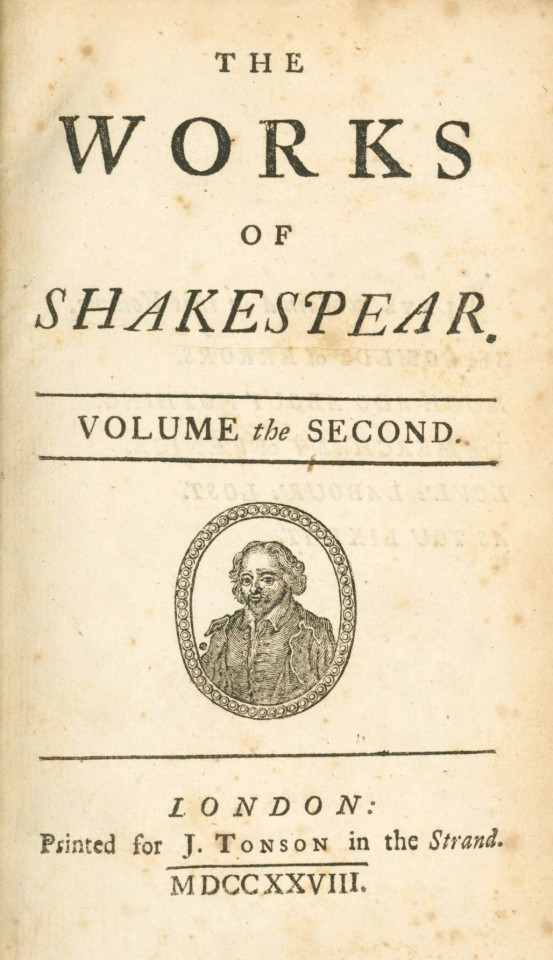
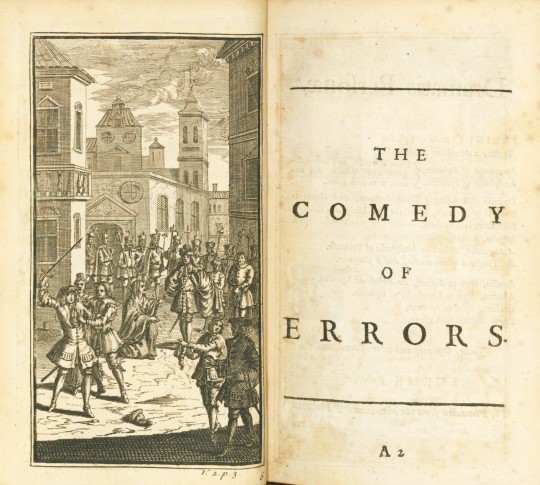
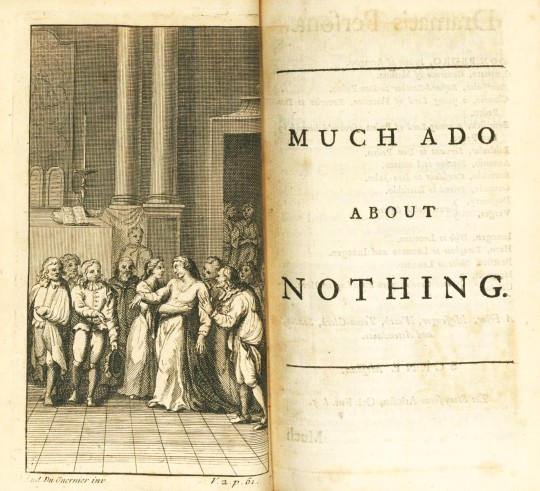

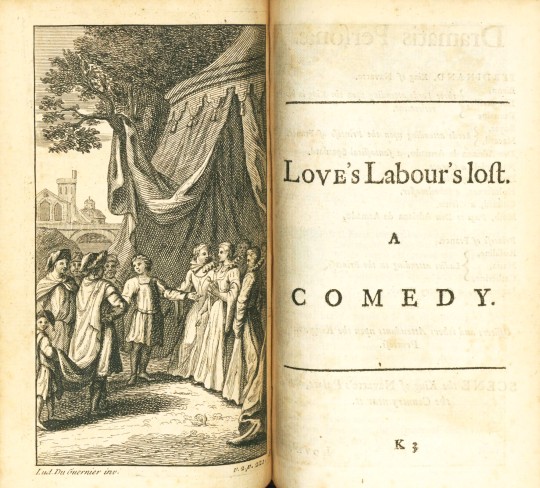
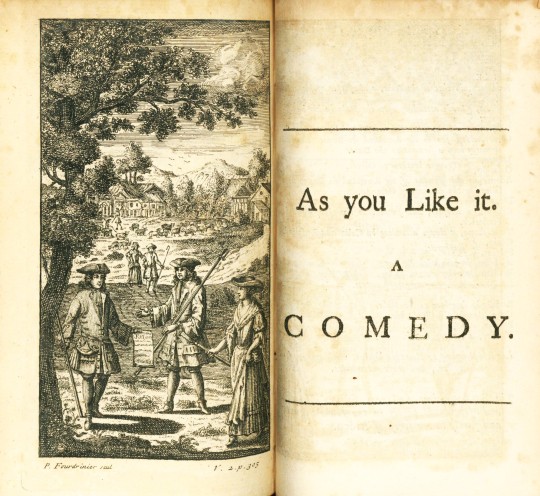
This week we continue our look at The works of Mr. William Shakespear: in ten volumes published in 1728 by Alexander Pope (1688-1744) and Dr. George Sewell (d. 1726) for Jacob Tonson (1655-1736). Similar to Rowe’s earlier collection, scene divisions, stage directions, dramatis personae, and full-page engravings by either French artist Louis Du Guernier (1677-1716) or Englishman Paul Fourdrinier (1698-1758) precede each play.
Pope’s editions of Shakespeare were the first attempted to collate all previous publications. He consulted twenty-seven early quartos restoring passages that had been out of print for almost a century while simultaneously removing about 1,560 lines of material that didn’t appeal to him. Some of those lines were degraded to the bottom of the page with his other editorial notes.
This process is called a variorum. Pope began a practice of producing Shakespeare variorum editions that continues to this day with the Modern Language Association's New Variorum Shakespeare Project. That project was centered here at the UW-Milwaukee Libraries for 30 years beginning in 1977 under the direction of Dr. Robert K. Turner, with the assistance of Dr. Virginia Haas.
Volume Two’s Comedy of Errors provides several examples of Pope's editorial additions, including using stars to denote scenes he felt were particularly lovely and daggers for those he found rather ugly. Other editorial notes within Volume Two are seen within Much Ado About Nothing where Pope points out additions from earlier editions and provides definitions for daffe and foining.

A star marking Pope's appreciation for the scene.

Editorial note by Pope.
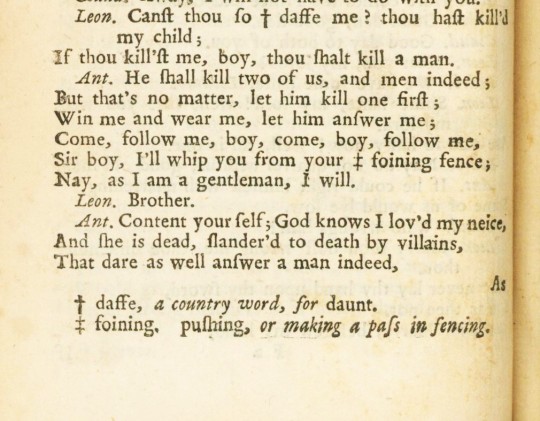
Inclusion of definitions by Pope.
Volume Two also includes Shakespearean comedies The Merchant of Venice, Love’s Labour’s Lost, and As You Like It.
View more Shakespeare Weekend posts.
-Jenna, Special Collections Graduate Intern
#Shakespeare Weekend#Shakespeare#william shakespeare#Alexander Pope#Dr. George Sewell#Jacob Tonson#Louis Du Guernier#Paul Fourdrinier#The Works of Mr. William Shakespear in ten volumes#Comedy of Errors#Much Ado About Nothing#Merchant of Venice#Love's Labour's Lost#As You Like It#variorum#variorum editions
19 notes
·
View notes
Text
Shakespeare Weekend



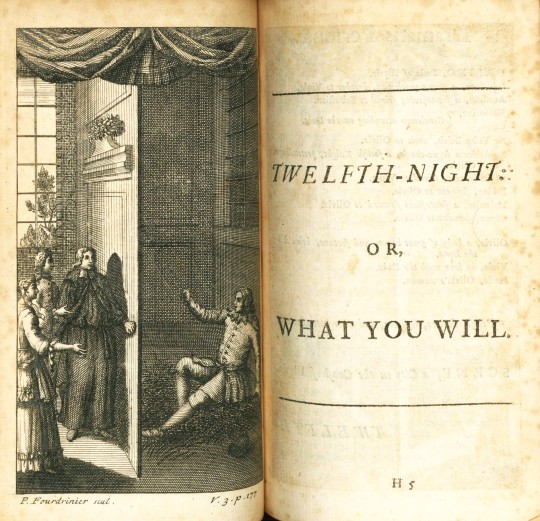



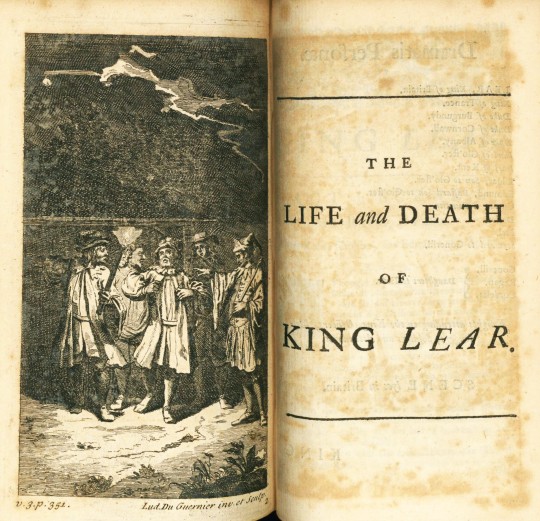
This weekend we return to The Works of Mr. William Shakespear: in ten volumes published in 1728 by Alexander Pope (1688-1744) and Dr. George Sewell (d. 1726) for Jacob Tonson (1655-1736). Similar to Rowe’s earlier collection, scene divisions, stage directions, dramatis personae, and full-page engravings by either French artist Louis Du Guernier (1677-1716) or Englishman Paul Fourdrinier (1698-1758) precede each play.
Volume Three of Pope’s work is a thematic variety pack containing comedies, dramas, tragedies, and Shakespeare’s problem play All’s Well that End’s Well. Other plays published within the volume include The Taming of the Shrew, Twelfth-Night; or, What You Will, The Winter’s Tale, and King Lear.
Four out of the five engravings in Volume Three were done by Paul Fourdrinier, who was well known throughout England for his exquisite architectural engravings. Fourdrinier’s attention to architectural detail can be seen in his precisely ornate scene settings and talent at creating depth through cross-hatching shadows and voids. Fourdrinier worked with Tonson several times over the course of his career and founded a stationary business that was eventually taken over by his grandsons who also notably developed a eponymous paper-making machine.
Pope’s editions of Shakespeare were the first attempted to collate all previous publications. He consulted twenty-seven early quartos restoring passages that had been out of print for almost a century while simultaneously removing about 1,560 lines of material that didn’t appeal to him. Some of those lines were degraded to the bottom of the page with his other editorial notes.
View more Shakespeare Weekend posts.
-Jenna, Special Collections Graduate Intern
#shakespeare weekend#william shakespeare#the works of mr. william shakespear: in ten volumes#alexander pope#dr. george sewell#jacob tonson#nicholas rowe#louis du guernier#paul fourdrinier#all's well that ends well#the taming of the shrew#twelfth night#the winter's tale#king lear#engravings
16 notes
·
View notes
Text
Shakespeare Weekend
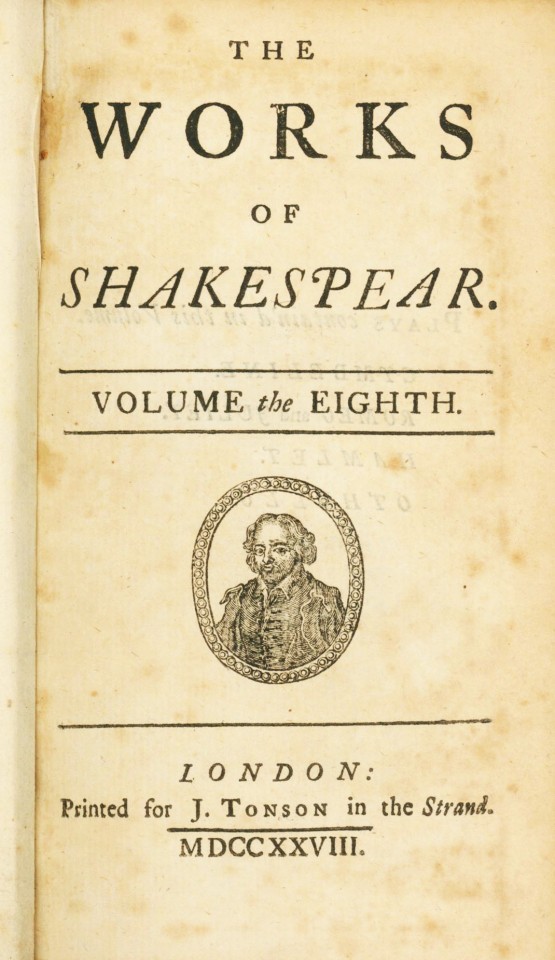
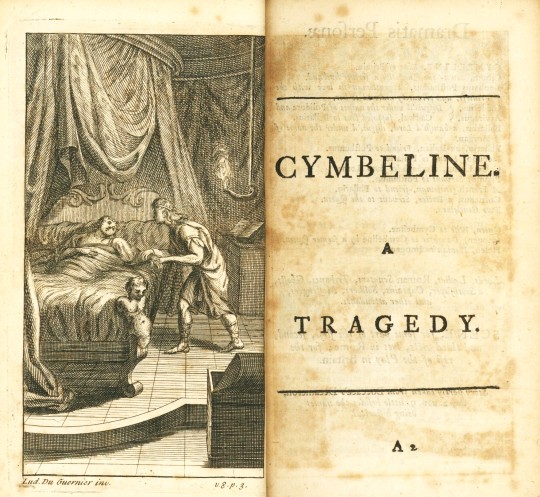
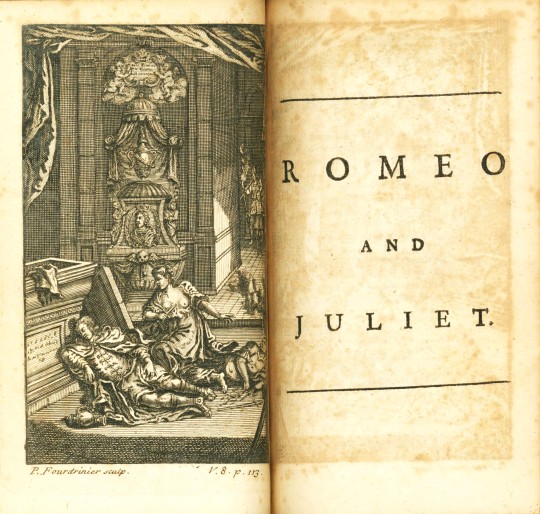
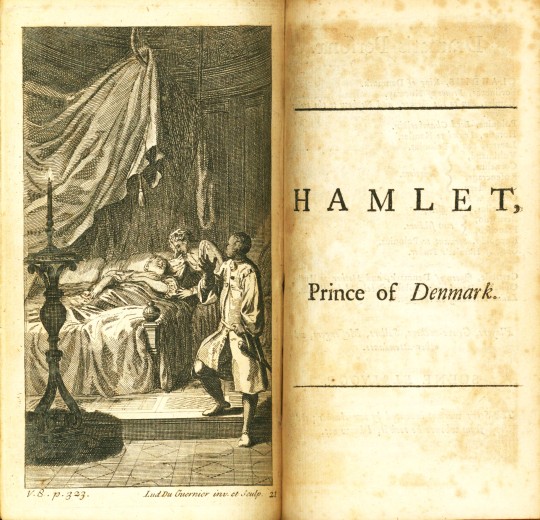
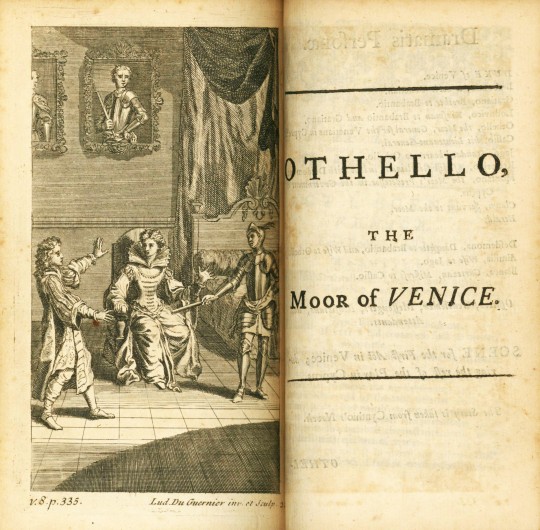
The works of Mr. William Shakespear: in ten volumes published in 1728 by Alexander Pope (1688-1744) and Dr. George Sewell (d. 1726) for Jacob Tonson (1655-1736), is considered complete in 8, 9, or 10 volumes. Pope’s second edition, as we see here, was published in 8 volumes with supplementary 9th and 10th volumes.
As such, Volume Eight includes an index of the characters, sentiments, speeches and descriptions found throughout the first eight volumes. It concludes with, in Pope’s words, “various readings and guesses” that Lewis Theobald (1688-1744) had published in 1726 as editorial amendments to the collection with the intent to “restore the true reading of Shakespeare”. In a bit of catty accusations, Pope claims Theobald had originally withheld his information at the time of the first pressing, and that he only used roughly twenty-five words of Theobald’s corrections in the second edition.

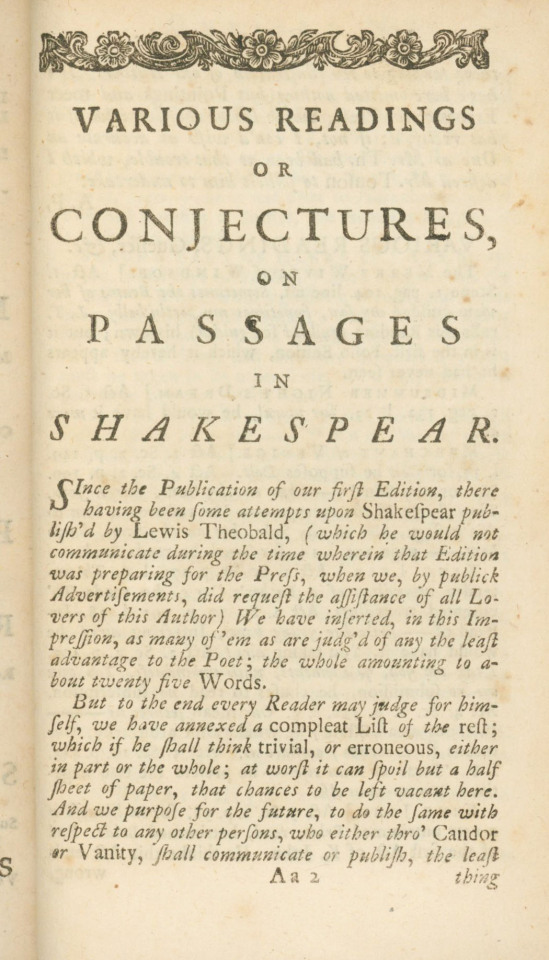
The plays within volume eight are all tragedies dealing with themes of innocence, jealousy, revenge, and fate; they include Cymbeline, Romeo and Juliet, Hamlet, and Othello. Pope notes that the story of Hamlet was not invented by Shakespeare but that its source is unclear. Regardless, Hamlet is hailed as one of the greatest plays of all time and at 29, 551 words is Shakespeare’s longest.
Pope’s editions of Shakespeare were the first attempted to collate all previous publications. He consulted twenty-seven early quartos restoring passages that had been out of print for almost a century while simultaneously removing about 1,560 lines of material that didn’t appeal to him. Scene divisions, stage directions, dramatis personae, and full-page engravings by either French artist Louis Du Guernier (1677-1716) or Englishman Paul Fourdrinier (1698-1758) precede each play.
View more Shakespeare Weekend posts.
-Jenna, Special Collections Graduate Intern
#shakespeare weekend#william shakespeare#shakespeare#the works of mr. william shakespear in ten volumes#alexander pope#dr. george sewell#jacob tonson#lewis theobald#cymbeline#romeo and juliet#hamlet#othello#louis du guernier#paul fourdrinier#engravings
6 notes
·
View notes
